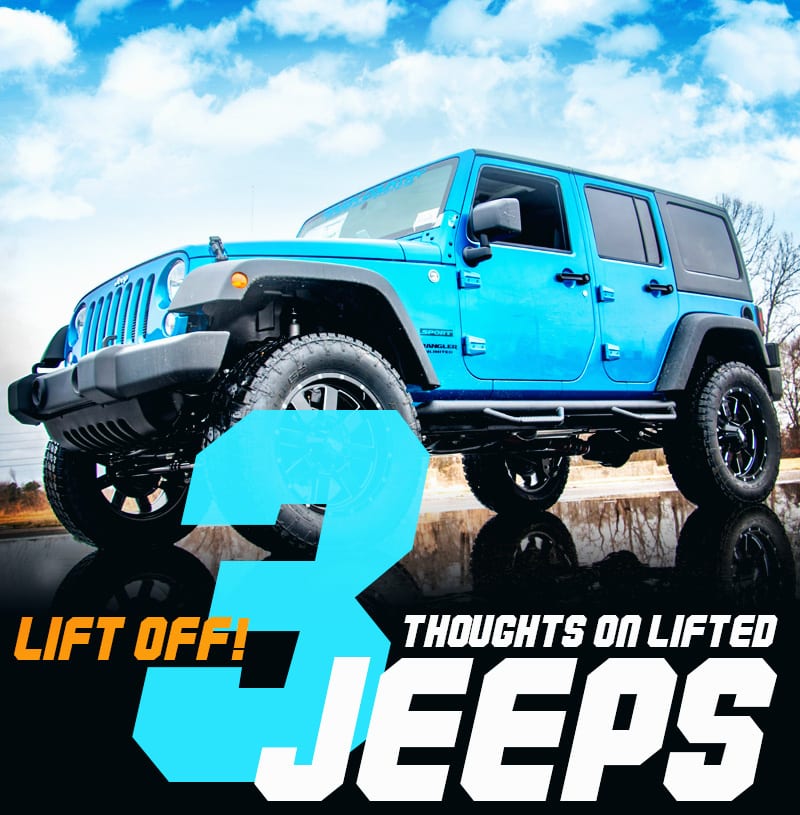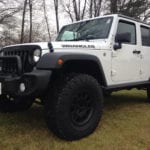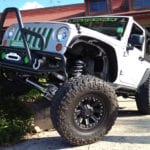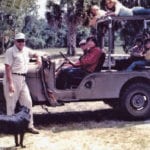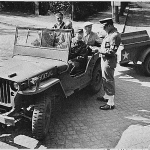Did you just purchase a Jeep? You may be impressed by the vehicle’s incredible capabilities, but drivers always seem to be seeking more. If you want to truly appreciate your Jeep’s off-roading abilities, the installation of a lift kit could provide you with an unmatched driving experience. With the inclusion of this modification, drivers can overcome any types of obstacles, obtain a more advantageous vantage point of the road, or they can simply add some intimidation to their new ride.
As you’re determining which Jeep lift kit would best fit your individual needs and desires (or even if you’re simply searching for a lifted Jeep for sale), there are some things you’ll want to consider…
Driving Habits
When researching a specific lift to pursue, you’ll want to note your personal driving habits and tendencies. If you’re going to rely on the lift kit for off-roading purposes (whether it be trekking through streams or crawling over rocks), you’ll require a more rugged system. Meanwhile, if you want to adapt your Jeep to harsh weather (or if you just plan on adding an edge of intimidation to your Jeep), you won’t need nearly as elaborate of a system.
Budget
Finances are especially important when it comes to lifting your Jeep, as you’ll have to allocate money for the accompanying additions to your vehicle. For instance, a body lift or budget boost lift might cost you between $200-$500, but you may dish out more money for some larger and more expensive off-road tires. Therefore, the price of modifying your Jeep can add up quick. You’ll need to account for these necessary features (like the new tires), so don’t waste your entire budget on just the lift kit itself.
Speaking of tires, it’s usually a good idea to pursue new rubber after having lifted your Jeep. Your standard tires may not be able to compensate for the difference in height, resulting in reduced performance. There are affordable tires available for those simply looking to lift their Jeep for style, but customers can also dish out money on expensive (but very capable) off-roading choices.
Remember that safety should always be a top priority, especially when your Jeep is undergoing such a drastic modification. While you may be able to save a few dollars by pursuing a lesser-quality part, remember how these underperforming additions could impact your ride. If someone is offering to lift your suspension for $100.00, which is less than a body lift and involves a lot more labor, then the offer is probably too good to be true.
As a general rule of thumb, the more expensive the lift, the more modifications are needed, which also means the more expensive the lift, the more benefits it provides you and your Wrangler.
Types of Lift Kits
There are several different ways that you can lift your Jeep. You can choose a body lift, which is a cheaper lift that lets you raise the body away from the frame, but leaves the suspension and other components in their original setting.
Or, you can get a budget boost lift, which is another affordable lift that provides your Jeep with some increased suspension height by installing spacers on the coil springs and larger shackles on a YJ. A coil spring lift is another option and simply installs bigger after market coil springs for added articulation and suspension performance. Finally, there are short and long arm suspension lifts, which actually raise and improve the suspension itself, and provide better overall ground clearance.
Important to note: Whether you choose a coil spring, short arm, or long arm lift kit, you are still changing and lifting the suspension. Therefore, the center of gravity on the Jeep has been raised, which in turn increases the likelihood of rolling over or tipping if not driven properly.
Body Lift
A body lift is an affordable way to add some intimidation to your Jeep. You can typically get a body lift for around $200.00, which can lift the Jeep about 1-3 inches without needing new shocks or other components. Installing taller spacers and bolts between the frame and the body is what gives technicians the capability to do this. Of course, depending on how high the driver wants to lift his or her Jeep, the modification may require the inclusion of new components for the vehicle’s most essential parts. Because while 1-3 inches is typically all you need for an off-roading rig, some Jeepers might want a little bigger and beefier looking vehicle.
Unfortunately, the lift is primarily visual, as you probably inferred from the lack of mechanical alteration. Also, a body lift doesn’t provide improved ground clearance like a suspension lift because you aren’t actually lifting the suspension. Since those components are left at their stock height, your Jeep won’t gain any extra ground clearance. On the other hand, being able to equip your Jeep with larger tires will give you some other off-road benefits, like more traction, thanks to the increased tire size.
With that in mind, if what you’re interested in is primarily aesthetic, then this could be the option for you.
Budget Boost
A budget boost is another affordable lift, and provides some more off-road benefits when compared to a body lift. But, this budget boost lift is also mainly for looks.
A small increase to the suspension height results from spacers installed on top of the coil springs, or — on YJ models — larger shackles. This is also a very simple lift to install, but it’s important to note that it can potentially cause issues if new shocks or extensions aren’t installed as well. When this type of lift is installed with those stock components, you run the risk of bending shock mounts. So, although it’s easy and inexpensive to install, there is slightly more to it than a body lift.
These parts don’t necessarily add height to the Jeep, but they better adapt the vehicle to bigger off-roading tires. While tire options on a body lift are limited, there are many more choices when a driver opts for a budget boost.
Coil Spring Lift Kit
Much like a suspension lift, a coil spring lift can significantly impact the height and center of gravity of your vehicle. Also, this type of lift doesn’t apply to a YJ model, only the TJ and JK Wranglers — since the YJs still use a leaf spring suspension. This type of lift involves simply installing larger after market coil springs, which improve the articulation (flexibility of the suspension) on rugged off-road terrain. Also, because these larger springs increase the distance between the frame and the axles, the Wrangler experiences increased ground clearance, and it also allows for larger tires.
The larger lifts may include new control arms to help maintain the suspension alignment, which helps smooth out highway driving. But, since the center of gravity is raised, it’s easier to tip the vehicle whether you’re traveling on or off the road.
Short Arm/Long Arm Lift Kit
Short arm and long arm lift kits deal directly with the suspension, and actually alter and raise it a certain height. In general, they are both more expensive and complicated than any of the lifts previously mentioned, but also provide the most off-roading benefits thanks to the alteration of the suspension and increased ride height.
If what you are looking to do is mudding, rock-crawling, and hitting more rugged off-road trails, a short arm lift kit is what you want. This lift kit can handle up to a 3.5-inch suspension lift without a noticeable shift in driving quality. Thanks to the snug-fit it provides everything underneath, it’s perfect for rock-crawling. Since none of the components are hanging lower than the suspension, you gain much more ground clearance than a long arm lift, and won’t get hung up as much when crawling over rocks. The downside, however, is it’s rough on highway driving. So if your Wrangler is a dedicated crawler, go for it. Otherwise, grab a long arm lift kit.
The long arm lift kit is more for fast off-roading and driving on the street. Therefore, if your Wrangler is a daily driver or a dune-runner (goes fast in the desert or on the beach), this is the one you’ll want. In order to get this smoother handling though a long arm lift must attach much further back, which takes up more space than a short arm, decreasing the ground clearance, and potentially getting hung up easier when crawling over obstacles.
In Conclusion…
Finally, while this may seem rather obvious, you wouldn’t believe how many Jeep owners will trust their ride in the hands of a complete stranger. Make sure that you’re working with a reliable business before you attempt to modify your ride. Safety should remain a priority and improper installation of a lift kit could put you and your passengers in danger.
Of course, the easiest route is pursuing an already-existing lifted Jeep from a used-car dealership. While you may not be overseeing the modification yourself, you can at least understand what each of these individual kits will ultimately provide.
